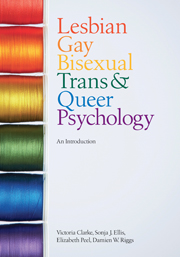Book contents
- Frontmatter
- Contents
- List of boxes
- Introduction: how to read and use this book
- Section I History, contexts and debates in LGBTQ psychology
- 1 Introducing LGBTQ psychology
- 2 Key debates and perspectives
- 3 Doing LGBTQ psychological research
- Section II Understanding social marginalisation in LGBTQ lives
- Section III LGBTQ experiences across the lifespan
- Conclusion
- Glossary
- Additional resources
- References
- Index
- References
3 - Doing LGBTQ psychological research
from Section I - History, contexts and debates in LGBTQ psychology
- Frontmatter
- Contents
- List of boxes
- Introduction: how to read and use this book
- Section I History, contexts and debates in LGBTQ psychology
- 1 Introducing LGBTQ psychology
- 2 Key debates and perspectives
- 3 Doing LGBTQ psychological research
- Section II Understanding social marginalisation in LGBTQ lives
- Section III LGBTQ experiences across the lifespan
- Conclusion
- Glossary
- Additional resources
- References
- Index
- References
Summary
Overview
• Research methods and approaches
• Issues in doing LGBTQ psychological research
Imagine you are undertaking a research project in LGBTQ psychology (some readers may not have to imagine). Your first step is to identify your theoretical assumptions (see Chapter 2). Do you subscribe to the assumptions of social constructionism, positivist-empiricism or something else? Your theoretical assumptions will (generally) determine your methodology (quantitative, qualitative or a combination of the two), and your methodology, in turn, determines which methods of data collection and analysis you may use. The earliest research on LGBTQ people – the work of sexologists such as Krafft-Ebing and Havelock Ellis – relied on case studies, that is the sexual and gender histories of individual homosexuals, transsexuals and others living outside of social norms around sex/gender and sexuality. Today LGBTQ psychologists use a wide range of methods to collect and analyse data about the lives of LGBTQ people and LGBTQ sexualities and genders. This chapter outlines the main methods used by LGBTQ psychologists and considers the strengths and weaknesses of different approaches to research. The chapter also has a broader focus on the issues and dilemmas that psychologists encounter when researching LGBTQ populations. It provides guidance to researchers undertaking their first project on LGBTQ issues and highlights good practice in researching LGBTQ populations.
Research methods and approaches
We have organised our discussion of the different methods and approaches used by LGBTQ psychologists around the conventional, if problematic, quantitative/qualitative divide.
- Type
- Chapter
- Information
- Lesbian, Gay, Bisexual, Trans and Queer PsychologyAn Introduction, pp. 52 - 78Publisher: Cambridge University PressPrint publication year: 2010



